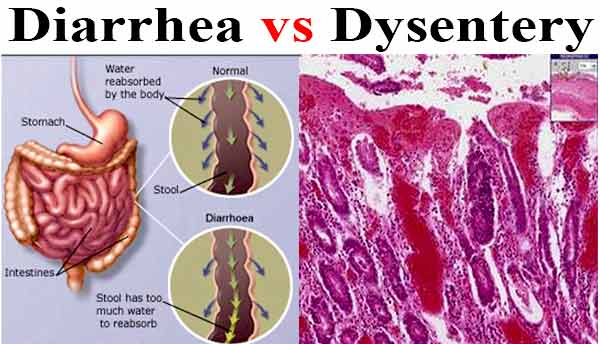Diarrhea is a condition that involves the frequent passing of loose or watery stools while Dysentery is an intestinal inflammation, especially in the colon, that can lead to severe diarrhea with mucus or blood in the feces.
The major differences between Diarrhea and Dysentery are as follows:
| S.N. | Diarrhea | Dysentery |
|---|---|---|
| 1. | Diarrhea is presented as watery stool with no blood and mucus. | Dysentery is presented as a mucoid stool that may be accompanied by blood. |
| 2. | The patient may or may not be accompanied by cramps or a pain. | The patient usually complains of cramps and pain in the lower abdominal area. |
| 3. | Fever is less common in diarrhea. | Fever is more common in dysentery. |
| 4. | Diarrhea is a disease that affects the small bowel. | Dysentery is a disease that affects the colon. |
| 5. | Diarrheal infection is located and targets only intestinal lumen and upper epithelial cells. | Dysentery not only upper epithelial cells are targeted but colon ulceration also results. |
| 6. | There is no cell death in diarrhea and the infection is only caused because of the release of some toxins by the infecting agent. | When a person gets dysentery, the upper epithelial cells are attacked and destroyed by the pathogen or disease causing agent. |
| 7. | The antimicrobial that are used to treat diarrhea do not eradicate the toxin left behind. | Treatment for dysentery can eradicate the pathogen that is causing the infection and stop the inflammation. |
| 8. | The effects of diarrhea are not that serious, apart from a risk of dehydration. | Dysentery can cause a lot of complications, if left untreated. |
| 9. | Diarrhea is mostly viral. E. coli can also cause watery diarrhea. | Dysentery is mostly bacterial. E coli, Shigella, and Salmonella are the most common causative organisms |
| 10. | Diarrhea does not need antibiotics. Oral rehydration solutions or intravenous fluid therapy may be used. | Dysentery almost always requires antibiotic treatment. Intravenous antibiotics may be needed in severely ill children. |
Similar Posts:
- Cryptococcus Neoformans – Habitat, Morphology, Epidemiology, Virulence Factors, Treatment + More
- Histoplasma Capsulatum – Habitat, Morphology, Epidemiology, Virulence Factors, Treatment + More
- Blood cells and its types with functions
- Normal Laboratory Values of Blood, Plasma, Serum, Urine, CSF and Stool


This is very helpful to me, it has made me understood clearly the difference between the two. Thanks
I love this post.this is good for every reader.i also like this type of ans..but you did not mention the results lik anaemia,underweight etc.and you did not mention the prevalence rate of both condition.
Yeah.. That’s important too.
When some one searches for his vital thing, thus he/she needs to be available that in detail, therefore that
thing is maintained over here.
Interesting and useful !! Suggest to provide differences bacterial and protozoal (ameobic) dysentery as well !
Dear Dr Aryal,
Good differentiation between the two.
In my consideration the frequency of stool is diarrhoea. It should be divided on the basis of
1. Secretory
2. Inflammatory.
The fever is not marked in case of watery diarrhea.
about the Protozoal cause ( eg. cystoisospora belli, cryptosporidia ect. They can cause diarrhea in immunoconpetent hosts also. But when they cause infection if Immunocompromised host they cause invasive infections and can lead to mucus and blood in the stool.
Thanks and regards
Dr.Anant Marathe.